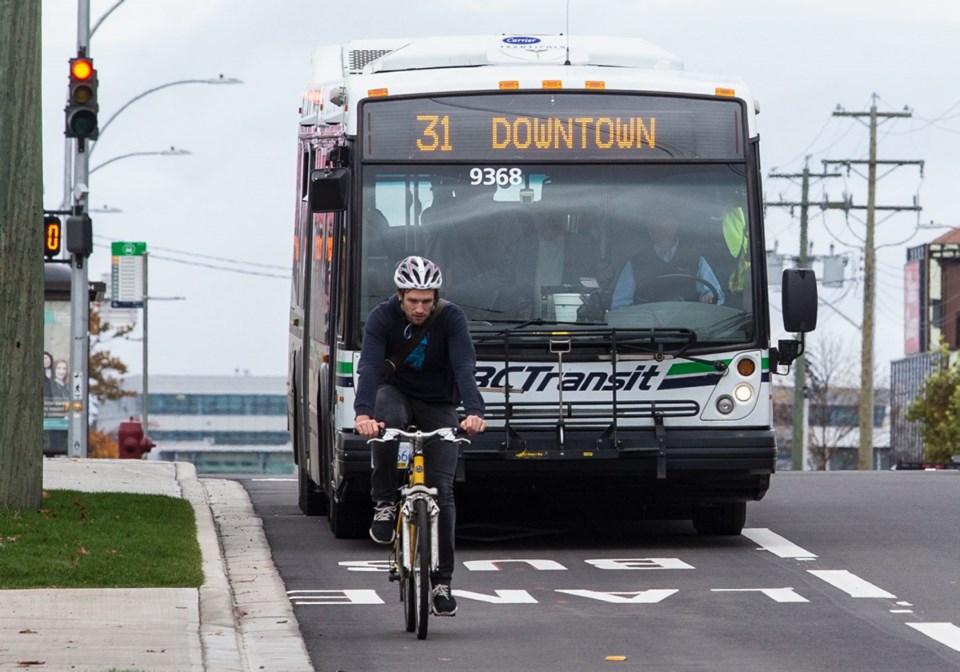 It turns out that sticking bikes and buses in the same lane isn’t the perfect solution.
It turns out that sticking bikes and buses in the same lane isn’t the perfect solution.
One goes fast, the other goes slow. No matter how frantically the cyclist pedals, it doesn’t take long before the broad face of the bus casts a shadow over the bike, which is, gosh, a totally comfortable way to ride.
Not much fun for the bus drivers, either. The whole idea of the new Douglas Street priority lanes was to speed the trip for transit users, but with no room to pass safely in rush hour, the buses get stuck poking along at the same speed as Mary Poppins on her two-wheeler.
Which is why the bus drivers’ union is asking if there’s a better way to do things — not that the drivers are complaining all that loudly. The new lanes have made for a faster trip, just maybe not as fast as it could be.
“It’s an issue, but it’s not an issue that’s the end of the world,” says Ben Williams, the president of Unifor Local 333BC. “If this is the best we can do, we can accept that.”
The bus-and-bike lanes that now run down both sides of Douglas between Fisgard and Tolmie were built piecemeal over the past few years, with the first bits barring cars only during rush hour.
Now that the project is complete, with cars banned 24 hours a day (unless they’re turning right), drivers say they’re being slowed by bikes. Buses can usually pass them in off-peak times, but at other times it’s too congested.
At least in the old days there were stretches of Douglas Street where a strip of paint gave cyclists their own lane. “When those were there, a bus could pass,” Williams says. No longer. There’s no longer enough room for bike lanes. Remember, the barely-wide-enough-for-a-bus priority routes didn’t replace traffic lanes; they were squeezed in beside what was already there.
Fraser Work, Victoria’s director of engineering, isn’t so sure the bikes cost that much time.
“I think it’s a bit premature and a bit misleading to say it’s bikes that are slowing things down.”
More problematic is the volume of cars turning onto or off of Douglas in front of the buses. Then there are the buses that block other buses while disgorging passengers. “All these things are going to dictate the pace of the trip,” Fraser says.
Planners do what they can to keep things moving. Note that about half the buses on Douglas are equipped with technology that “talks” to traffic lights, extending green lights by long enough to get them through intersections.
From a cyclist’s perspective, sharing a lane with a bowling alley on wheels is far from ideal. “It’s an ugly compromise,” says Corey Burger of the Greater Victoria Cycling Coalition. Let’s not pretend these are the all-ages, all-abilities bike routes so often touted by the city.
Still, the picture is rosier than it was before, Burger hastens to add. The comfort factor has risen. “They are speeding up transit, which is a crucial goal.”
Yes, it is. With the population of the downtown continuing to rise, we can’t keep jamming more and more traffic into the city’s core. If we don’t want gridlock, some people will have to get out of their cars.
You go first.
The reality is that for all the talk about the need to get people out of their cars, Vancouver Island had 47,000 more insured vehicles in 2017 than 2013.Few will surrender a car’s comfort and convenience if all that is gained by riding the bus is the few minutes promised by a few blocks of dedicated bus lanes.
On the other hand, if the dream of dedicated bus lanes all the way from downtown to the Juan de Fuca recreation centre in Colwood comes true, that would be a game-changer, Williams figures. Shaving 20, 25 or 30 minutes from the daily commute would have anyone clamoring for the faster alternative.
Work looks into the future and sees even more dramatic possibilities, such as high-performing bus lanes proving so successful that the city will no longer need all those traffic lanes and will be able to dedicate more space to forms of public transit running down the centre of Douglas Street. (And cyclists might be able to ride without going into sphincter-tightening mode.)
That echoes an earlier proposal, one that grew out of a provincial government initiative in 2007, that would have seen buses get their own dedicated lanes in the middle of Douglas. Advocates liked the idea because there would be no conflict with cars and bikes in the right lane. Opponents hated the idea because it would have eliminated left-hand turns. The opponents won.
The future of transportation will be the subject of the city’s Go Victoria planning process, which will launch with a Jan. 24 public event at the Victoria Conference Centre. For more information, see the Eventbrite page.



